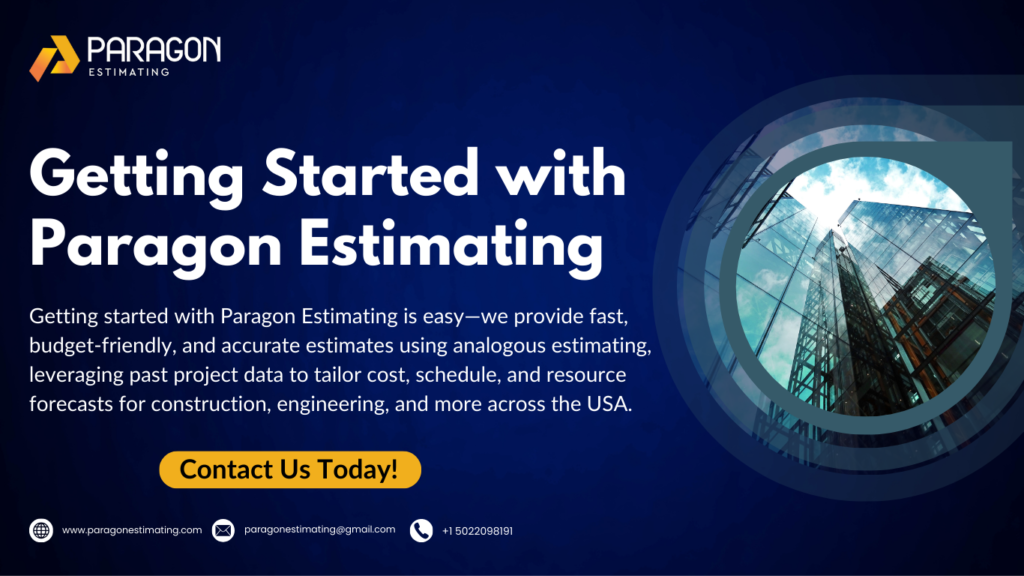Accurate Project Estimates with Analogous Estimating
At Paragon Estimating, we specialize in the powerful technique of analogous estimating, a fast and cost-effective method used in project management. Drawing on historical data from similar projects, we help businesses accurately predict project costs, timelines, and resource needs. Whether in the early planning stages or seeking an efficient cost estimator, our approach ensures you make informed decisions and stay on track. Trust Paragon Estimating to offer consistent, accurate projections catered to your project requirements.
What is Analogous Estimating?
Analogous estimating is an essential tool in project management for forecasting resources, time, and money needed. Estimating project parameters quickly and affordably depends on historical data from past comparable projects. This method is often used when thorough knowledge is inaccessible, but historical reference material can offer a strong basis. Using knowledge from earlier initiatives, project leaders can apply similar estimations to guide decisions and create reasonable expectations for a new project.
How Does Analogous Estimating Work?
Analogous estimation is matching the present project with historical projects. If you’re handling a construction estimating project and have worked on projects with similar scope, size, and difficulty, you can estimate the cost and timeline based on that data. The more closely comparable the past project is to the current one, the more accurate your analogous estimate will be.
Some of the benefits of using analogous estimating include:
- Quick Results: This approach is more effective than thorough estimation techniques since it uses current data.
- Low Cost: Analogous estimating is less resource-intensive than other approaches, saving time and money.
- Perfect for Early Stages: It is very helpful early on in a project when estimates are required only.
Why Analogous Estimate is Crucial for Project Management
In the busy field of project management, a good project depends mostly on precise estimates. Analogous cost estimates are crucial, particularly when operating under strict timeframes and financial restrictions. This method will help you control customer expectations, prevent expensive errors, and guarantee the timely delivery of your project.

The Role of Analogous Estimating in Project Management
Analogous estimation is important in project management. It enables project managers to estimate resources, time, and cost, among other aspects. It is especially helpful when performing several tasks and matching them with organizational objectives. Analogous Estimates in Project Management can guarantee they are on the correct path by using similar estimating methods instead of difficult and time-consuming complete estimation procedures. This helps them deploy resources effectively and make decisions based on facts.
Unlike more complex methods like Parametric Estimating or Three-Point Estimating, analogous estimating offers a faster, more intuitive way to forecast project requirements. It’s particularly valuable for organizations that frequently handle similar projects such as those using our Residential Estimating Services or Commercial Estimating Services—because it enables standardization and consistency across estimates. This method also simplifies communication with clients and stakeholders by providing easy-to-understand projections, making it a practical choice for early client presentations and budget approvals.
Benefits of Analogous Estimating in Project Management
Analogous estimating, also known as top-down estimating, is a powerful technique widely used in early project planning stages. By referencing historical data from similar past projects like drywall estimating and flooring estimating, etc, project managers can create quick and reasonably accurate cost and duration estimates. Here are the key benefits of using analogous estimating in project management:
- Speed and Efficiency: Compared to other approaches, the same estimations can be computed in a fraction of the time.
- Reduced Risk: Using past data helps project managers predict possible issues and steer clear of typical mistakes.
- Cost Savings: This approach keeps expenses low by minimizing the need for further resources or comprehensive preparation.
- Ideal for Early Decision Making: When stakeholders need early cost projections to determine project feasibility, analogous estimating provides a solid starting point. It allows teams to compare similar projects and gauge whether to proceed.
How Analogous Estimating Works for PMP Certification
Analogous Estimating PMP (Project Management Professional) certification requires first mastering similar estimations. In practical project management, this is a fundamental approach you will apply. The PMP test also stresses this method; hence, passing the test depends on knowing how to implement it in practical projects.
Analogous Estimate vs. Other Estimation Techniques
Although similar estimating is sometimes compared to other methods, such as parametric and expert judgment, its special benefits should be appreciated.
Analogous Estimating vs. Parametric Estimating
- Analogous Estimating: Uses historical data from similar projects.
- Parametric Estimating: Uses mathematical models to predict costs or timelines.
Early planning initiatives would benefit most from analogous estimation since it is faster and simpler.
Analogous Estimating vs. Expert Judgment
- Analogous Estimating: Relies on data from past projects.
- Expert Judgment: Relies on the knowledge and experience of individuals.
Expert opinion can give a thorough assessment, even if similar estimating gives a more objective and data-driven approach.

Ready to Take Your Projects to the Next Level with Analogous Estimating?
Our estimate company offers thorough and consistent cost-estimating solutions through creative approaches, including comparable estimating. Whether you are overseeing a small project or a major corporate initiative, our team has the expertise to guarantee your project is precisely calculated, efficiently allocated, and within budget. Contact us with our team today to learn how we can help you with your cost estimating needs. We’re here to ensure your project’s success with accurate and reliable estimates.
FAQs
What is Analogous Estimating in Project Management?
Similar estimation in project management is comparing past and present projects to project resources, time, and cost prediction. When comprehensive data is not available, this method enables project managers to generate first estimations.
How Accurate is an Analogous Estimate?
The accuracy of an analogous estimate depends on how similar the previous projects are to the current one. The more closely related the past project is, the more accurate the estimate will be.
Can an Analogous Estimate Be Used for Any Project?
Indeed, most projects can benefit from similar estimations, especially if enough past data is accessible for a trustworthy comparison.
How Do I Use Analogous Estimating for PMP Certification?
Understanding how to use similar estimations inside a project management lifeline can help you achieve PMP certification. Passing the PMP exam depends on knowing when to apply this approach and its restrictions.
What is the Difference Between Analogous Estimating and Analogous estimating?
The term analogous estimate defines the actual prediction generated with a related approach.



